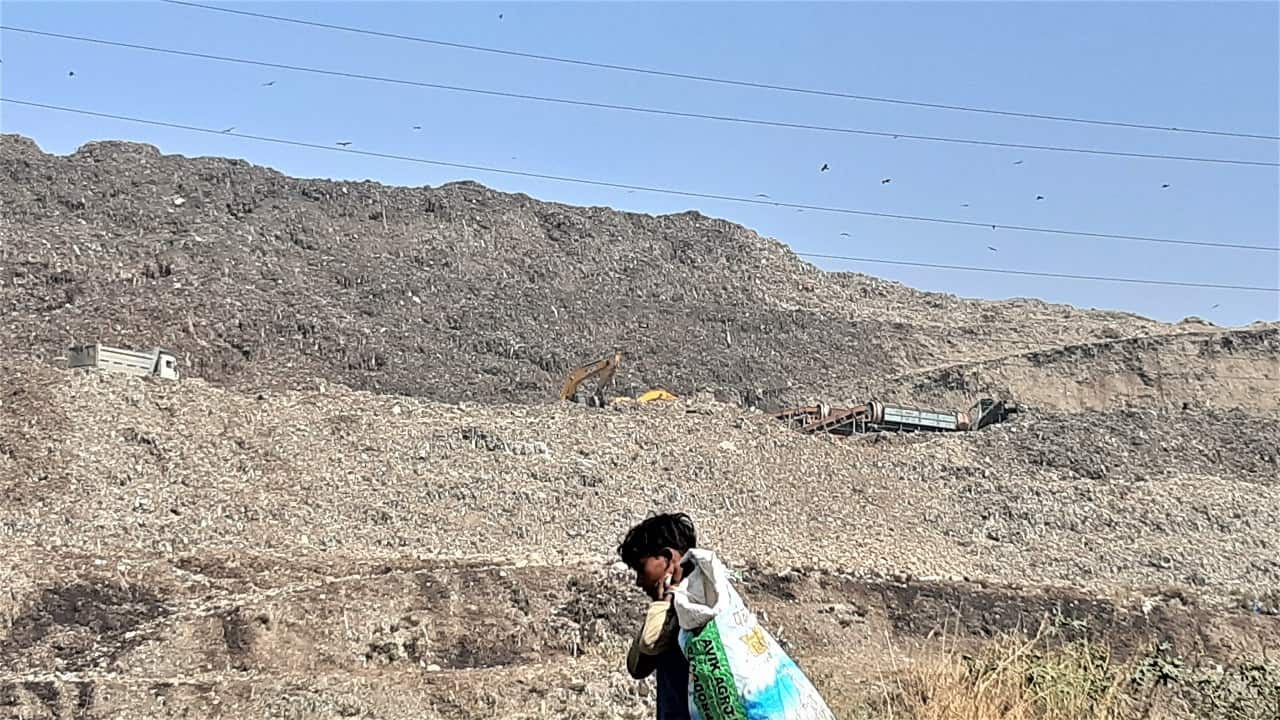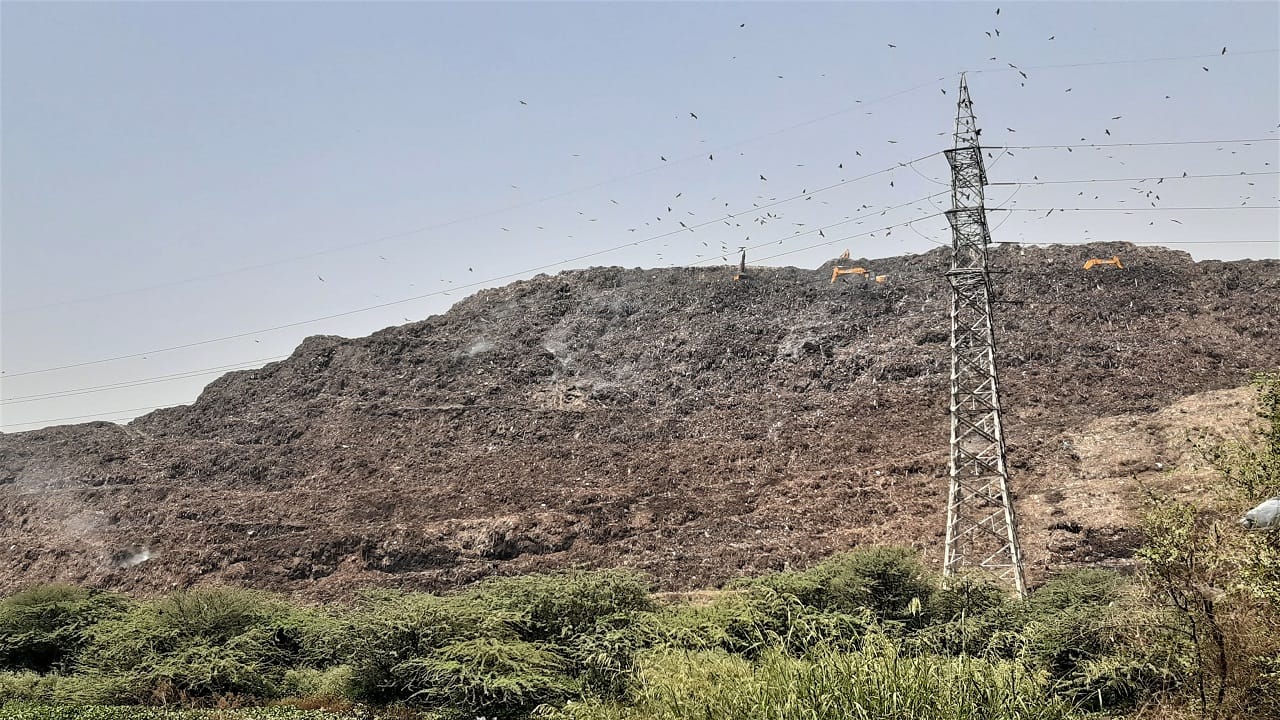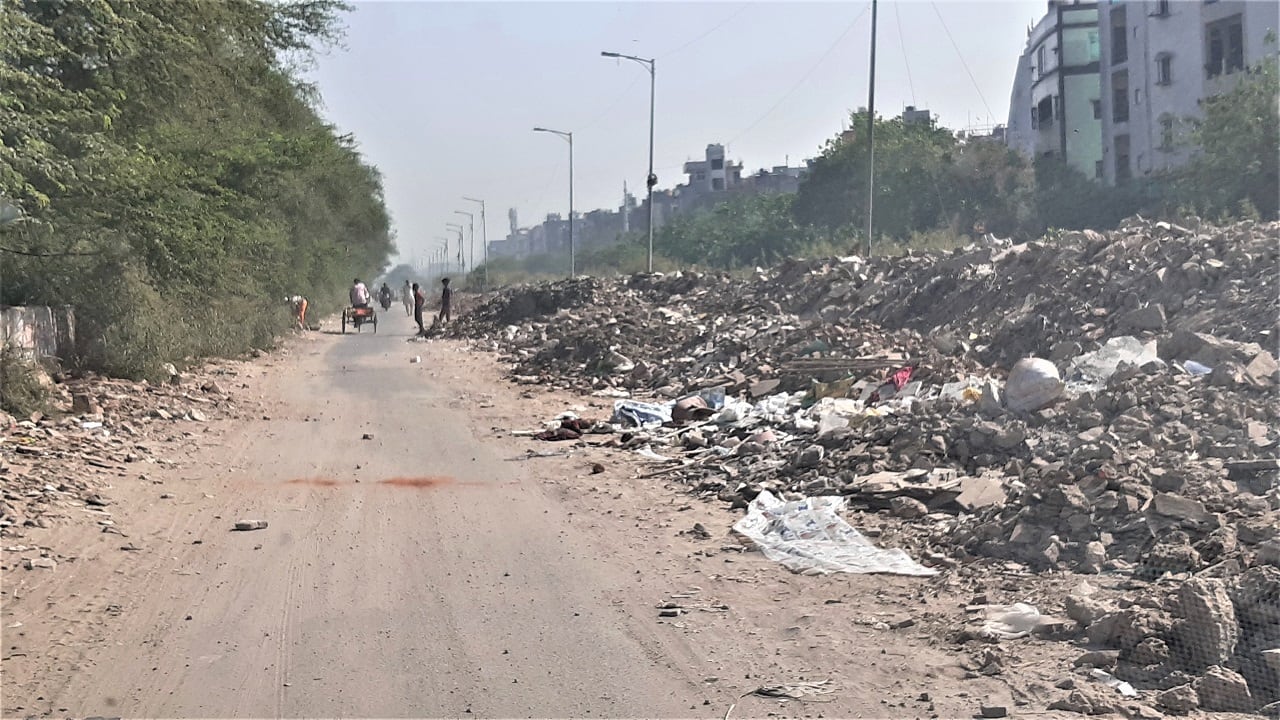



From a distance, anyone new to Delhi would take the Ghazipur landfill in east Delhi for a small hillock. Only a local resident would know it is a mountain of stinking garbage that was recently in the news for a raging fire that choked its surrounding neighbourhoods.
For people living in its vicinity, the landfill, located near Delhi’s border with Ghaziabad, UP, is like a fish bone stuck in your throat that you can neither swallow nor spit out.
That’s how Imran Ahmed, a resident of Mulla Colony, an unauthorised settlement abutting the toxic dump, describes it. Others refer it to as a long nightmare that never seems to end.
“Apart from the unbearable stench, we do not know what the foul air is causing inside our body. We have compromised as we can’t afford to shift,” Ahmed said.
Living with the stench
Mulla Colony is one of the many small colonies sharing their boundaries with the 70-acre landfill site.
The others are Ghazipur Dairy Farm, Sapera Basti, Rajveer Colony, Kondli-Gharoli, as well as numerous slums, which are directly exposed to the landfill’s toxicity.
Many of the residents work as labourers, rickshaw-pullers, scrap dealers, roadside vendors, factory workers and small traders, among other things.

The swanky 14-lane Delhi-Meerut expressway runs right next to the landfill’s entrance. The Ghazipur fish and poultry markets and a metro depot are located on both sides of the dumpsite.
Parts of middle and upper-middle-class residential neighbourhoods such as IP Extension, Mayur Vihar Phase 2 and 3 in Delhi, and Kaushambi, Vaishali and Indirapuram in Ghaziabad are within a 4-5 km airshed of the landfill.
On a bad day, even these areas, which house multi-speciality hospitals, star-rated hotels, malls and plush high-rises, cannot escape the landfill’s stench.
Residents of the settlements facing the landfill described how the area was a barren, low-lying land before it became a dumping ground.
Ahmed, a septuagenarian, has been living in the locality for more than four decades, even before the landfill came up. “I have seen the dumpyard grow with time,” he says.
Other old-timers recall that when they settled in the area, the nearby high-rise localities in IP Extension and Ghaziabad had not come up. There were wide fields filled with grass on both sides of the border.
“The authorities started dumping waste here, maybe because these are Delhi’s outskirts, but we were very few in number to oppose,” says Ahmed.
Yadav Singh, a resident of Ghazipur Dairy Farm, one of the oldest settlements in the area, has grown up with the landfill, which was commissioned in 1984, long before waste management rules were formed. Houses in the last row of the neighborhood are directly open to the garbage dump. His house is one of them.
“I was born in 1980. The landfill came up later. The smell gets unbearable when it rains. Our eyes burn. We keep our windows shut and cover our faces,” he says. Those who could afford to have left the area for better localities,says Singh. Others like him are left with no choice but to make peace with the foul air.

At Rajveer Colony, a group of elderly people were huddled together on charpoys (woven cots), smoking hookahs. They were initially reluctant to talk when this writer approached them. One of them even got a little aggressive.
“Why should we talk? What will we get? People come, take photos and disappear till another incident happens. The authorities turn a blind eye to our plight,” the person, who refused to be named, said.
Complaints galore
Residents point to the heaps of construction debris dumped on a road facing the dump yard and the sewage flowing onto a broken street in the colony.
Another local recalled how the entire government machinery had gathered when a section of the garbage mountain collapsed and killed two people on this very road. But everything was forgotten soon after.
In September 2017, after days of non-stop rain, mounds of loose garbage came hurtling down from the then 50-metre dump, sweeping cars and motorbikes into a canal that runs parallel to the road.
Two people died and nearly half a dozen were injured in the incident, which grabbed headlines, prompting the authorities to temporarily ban the dumping of garbage and prohibit the entry of ragpickers at the landfill.
But in the absence of alternatives, dumping continued at the site, which went on to reach a height of 65 metres in 2019, just eight metres short of the Qutab Minar. The maximum permissible height is only 20 metres.
Though steps such as bio-mining were taken after court orders to flatten the landfill, which reached its saturation limit in 2002, hundreds of tonnes of waste are being dumped daily, putting paid to efforts to reduce the height.
Bio-mining is a mechanical process to sieve and separate heavy components such as soil and stones from lighter ones such as plastic and paper.
Harshad Kumar, who runs a cycle repair shop at the edge of the dump, says it is all about livelihood for people with meagre sources of income. “I have been living here for 15 years. Who would like to live amid the stench and smoke? But I have a family to fend for,” sas Kumar, pointing out how hundreds live and work around the landfill just to make ends meet.
Prashad, a ragpicker who picks up metallic and recyclable stuff from the landfill, which he sells to scrap dealers, echoes Kumar. The low rents in the colonies are a big draw for people like him who cannot afford to pay much. “I bribe the guards at the landfill to gain entry. My skin itches but I have to go. Whatever I earn is barely enough,” Prashad said.
At the fish and poultry wholesale markets, the traders laugh off the problems with sarcasm, saying the stench from the markets is so strong that the smell from the dump makes them feel lighter.
“People have started wearing masks after Covid. We always had our faces covered,” quipped Abdul Zabbar, a fish trader.
For municipal employees, contractual workers and drivers at the dumpyard, the odour and pollution are workplace hazards that have to be borne.
“Someone has to do it. If the department has posted me here, I can’t say no. It is hard to breathe out here, but you get used to it over time,” says a municipal employee at the landfill site office, brushing away the dust on his hair and shirt.
As the temperature rises, fires are common at the landfill, which produces inflammable and self-combustible gases such as methane. The presence of plastic and paper is like a tinderbox. Minor fires go unreported and unnoticed, but the recent blaze was big enough for everyone to sit up and take note.
 The spot that caught fire
The spot that caught fire
When the landfill caught fire on March 28, the reason for which was not known, the smoke spread as far as 4-5 km, depending on the wind direction.
“I could feel the smoke sitting in my balcony. When it rains, we cannot open the windows. The stench comes inside when the wind blows this way,” says Suneel Jha, a resident of Kaushambi’s Seemant Vihar, 2 km away.
Jha says people have park-facing and hill-facing houses, but here “we have garbage-facing apartments”.
Health and environmental hazard
In the absence of proper segregation at the collection level, all kinds of garbage is dumped, including domestic waste, plastic, glass, construction and demolition debris, refuse from the poultry and fish markets, dairy farm waste, etc.
The deadly cocktail of gases, smoke, dust and leachate not only affects the health of people living in its vicinity but has a severe bearing on the air and groundwater. Anand Vihar, one of Delhi’s most polluted hotspots, is about a km from the landfill.
Studies conducted across the world, including by the UNEP and WHO, point to the health hazards such open landfills pose to people working at these places and to nearby residents.
A WHO report titled ‘Waste and human health: Evidence and needs’ says improper waste management and illegal waste shipments can result in soil, water and air pollution.
Living in the vicinity of a dumpyard can be a health risk for residents because they may be exposed to pollutants through different pathways: the inhalation of substances emitted by the site, contact with water or polluted soil, directly or through the consumption of products, or through contaminated water, the study says.
In fact, most locals this writer spoke to complained of watery eyes, skin irritation and breathing issues.
According to Anumita Roychowdhury, Executive Director, Research and Advocacy, Centre for Science and Environment, monitoring stations near the landfill showed worsening air pollution with both particulate matter and nitrogen dioxide levels increasing.
“This, combined with emissions of other toxic gases from fires, increases the toxic exposure of local communities significantly,” she says.
Waste mismanagement
The basic formula of a landfill is to dump, process and dispose, and not to dump and forget, which has been happening for years, explains Jagdish Mamgain, who was chairman of the unified municipal corporation of Delhi.
Delhi generates about 12,000 tonnes of waste every day, of which more than half is sent to the landfills at Ghazipur, Okhla in south Delhi, and Bhalswa and Narela-Bawana in outer Delhi.

Ghazipur alone has accumulated about 140 million tonnes of waste, according to the East Delhi Municipal Corporation’s own admission.
Efforts to set up an alternative site at Rani Khera in northwest Delhi and a waste management facility at Ghonda Gujran in the northeast have met with opposition and legal troubles.
Mamgain said plans for localised dump yards and waste processing plants had to be abandoned due to resistance from locals, when he was in the MCD.
Segregation and recycling of waste is only on paper and not in practice, he says, adding that this is the root of the problem.
The idea is to send minimum waste to landfills, Mamgain says, noting that if proper segregation happens at the collection level, construction and demolition debris can be used to make roads, wet waste can be turned into compost and other stuff can be sold with the help of waste-pickers.
“There are many alternatives. But if you mix them, everything ends up at the landfills,” Mamgain says.
RoyChowdhury says only a zero landfill policy based on 100 percent waste segregation, minimum dumping of fresh waste, and urgent remediation of legacy waste can address this problem.
Every municipality, she says, has to invest to create infrastructure and systems for this scale of action.
“I don’t know if I shall live long enough to see this gone, but our kids should breathe better air,” says Ahmed with a sigh.
Discover the latest Business News, Sensex, and Nifty updates. Obtain Personal Finance insights, tax queries, and expert opinions on Moneycontrol or download the Moneycontrol App to stay updated!